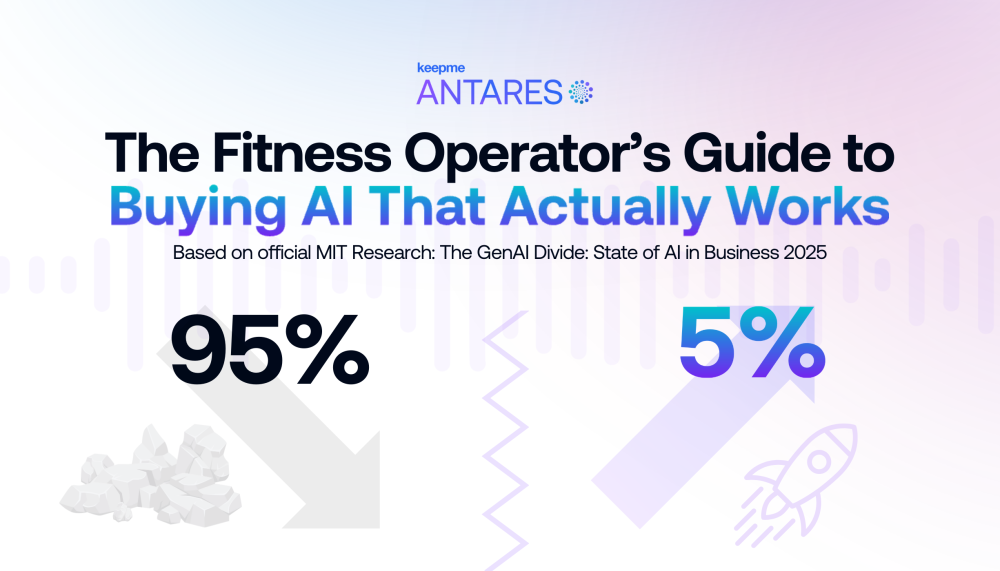Gym Membership Retention: It Matters


Updated - September 29 2023
When building a fitness business from the ground up it’s easy to get distracted by member acquisition. After all, you need paying members coming through the door to keep the lights on. However, falling into the trap of only focusing on new members costs your business revenue in the long run. Because no one is worrying about membership retention.
The ability to keep your gym members is just as important as your ability to attract new ones. What's more, existing members are far more profitable by the fact you’ve already paid to acquire them. Members who are an established part of your gym community are also far less likely to cancel increasing their lifetime membership value.
Offering your members competitive fees and state-of-the-art equipment will help with your retention. But ultimately, it won’t be the thing that keeps them coming back to the gym time after time. Or, more importantly, what will drive them to renew their membership each year.
Understanding gym membership retention, what motivates members, and how to execute membership engagement campaigns will transform the way your fitness center operates. And stabilize your revenue in the process.
The Importance of Gym Member Retention
Gym membership fees account for around 80% of overall revenue. As Helen Watts discovered was the case for a significant proportion of businesses studied in her paper “A Psychological Approach to Predicting Membership Retention in the Fitness Industry” (2012).
This means that recurring gym member fees are a vital component of revenue (and consequently, profit) generation for fitness businesses. And yet, according to the Fitness Industry Association’s figures in 2002, the average retention rate for a fitness club is 60.6%.
This means that each year, a club loses approximately 40% of its members! It is unsurprising, therefore, that the IHRSA has referred to membership retention as the “Achilles Heel” of the fitness industry.
Many incorrectly assume that if members leave, new members will just come in and replace them. But there are several factors to consider.
Firstly, competition within the fitness industry is growing. Your gym members have more choices both in terms of where to go and the style of the gym that suits them best. Competition also means more aggressive pricing, promotions, and introductory offers.
That drives up the cost of acquisition, doubly so when you factor in the increased marketing spend you’ll need. More competition means you need to work even harder to be heard.
So, members are harder to keep because competition is higher. Introductory offers result in lower recurring revenue. Cost of acquisition increases.
All this means profitability sharply falls. The data backs this up.
Gym Membership Saturation Point
The 2018 State of the UK Fitness Industry Report shows that the rate of growth of the fitness industry is slowing.
Between March 2017 to March 2018, the number of fitness facilities increased by 4.6 percent. Compared to 5% in March 2016 to March 2017.
IBISWorld, an international market research company, has made a similar warning, recently predicting that Australia’s gym market may reach saturation in the next five years.
So, there is no guarantee new gym members can make up for the revenue lost when existing members leave.
There are also inherent benefits to higher gym membership retention rates. Firstly, focusing business strategy on gym membership retention over acquisition reduces costs.
As the Harvard Business Review notes, the acquisition of new customers entails unique costs. For example, the costs associated with advertising, new member discounts, and the practice of giving ‘free trials’.
These costs are not incurred with membership retention. Thus, a shift in business focus towards retention will bring about cost savings, and increase profits.
Secondly, improving your gym membership retention rate can improve your rate of growth. With a more consistent gym member base, meaningful relationships between members and staff are more likely to develop.
This sense of community can drastically improve the gym member experience. As Phillip Mills once said, “People join to get results and motivation, but they stay because they make friends”.
When trust that their gym has their interests at heart, they are more likely to recommend your business to others. Retained customers, therefore, could also be a valuable form of word-of-mouth advertising for your business.
Cherish referral members because (a) they cost you nothing to get them and (b) they were already engaged with your business before they walked through the door.
Understanding Membership Behavior
Gym membership retention is important for health and fitness businesses to thrive. Despite the overemphasis on acquisition, there are wider factors making retention harder.
Firstly, fitness culture is changing. The concept of holistic fitness is becoming more popular and gym members are demanding greater variety in their fitness regimes.
Companies such as ClassPass and GuavaPass are stepping up to meet that demand.
The idea of long-term commitment to just one type of fitness facility or workout is becoming increasingly unattractive to consumers. There are also free online resources available for free that allow people to work out at home.
People can work out without spending a penny.
Secondly, staying fit isn’t easy. At almost every point of the fitness journey, there is the temptation to quit. In the beginning, fitness is difficult because the discipline and the good habits haven’t formed.
Even when that has been overcome, the motivation to keep exercising diminishes as sessions become repetitive and progress slows.
In addition, people often undergo life changes that make it challenging to keep up with their fitness routine. Whether it’s a change in job, marriage, or starting a family, time and attention are reprioritized.
Many exogenous factors can make someone leave a fitness center or gym, membership retention strategies aside.
Thirdly, and most importantly, health and fitness businesses simply aren’t doing enough to ensure that their members stay in the long run.
If gyms don’t actively prioritize membership retention, they won’t account for it in their business and resource allocation strategy. Many businesses even actively divert energy and resources into attracting new members rather than retaining existing ones.
As has already been discussed, this is a big mistake and is likely to be a significant source of the retention problem in the industry.
Add Value to the Gym Membership Experience
So, retention matters. But deciding you want to do more to retain members is like announcing you’re joining a gym.
Until you make a commitment and change your mindset, nothing will change.
Shifting away from an acquisition mindset to a retention-based one isn’t always easy. Especially as acquisition follows very similar processes and communication strategies. FOMO, aggressive offers, and incentives. They just get repackaged.
Retention is entirely about value and relevance. Providing we see something as relevant in our lives we’ll continue to use or invest in it. When that relevance stops, so do we.
So as gym operators, you need to ask yourself how you stay relevant to your members. Which brings us back to value.
Value, it’s important to understand, is relative. What matters to one member won’t necessarily matter to another. Although it’s reasonable to assume there is a baseline of common ground around the physical gym itself.
However, to stay relevant in your members’ minds, you need to demonstrate you understand them. The good news is that you have piles of membership data sitting in your various databases waiting to be used.
What’s more, providing your members are showing up, booking classes, and spending money on ancillary services, you’re gating more membership data all the time.
This first-party data, as it’s known, is a living record of everything your members have done. You can use this data to personalize membership engagement. Everything from personalized class invitations to product recommendations including color and size. It’s all possible by leveraging your first-party membership data.
Ask Questions for Deeper Membership Personalization
As soon as you start to get some momentum behind your membership retention strategy, you can start to ask questions.
Surveys are a great way to learn more about your members. Moreover, they also help to make your members feel heard as they get to directly comment on their experiences.
Providing you (a) promise to take on board their feedback and (b) make changes where needed, it’s a hugely positive experience for members. Even for the ones who have legitimate grievances. Again, it’s about feeling heard.
Gathering zero-party data (information supplied by the member) is the final piece of the puzzle. Whereas first-party data is what the member has done, zero-party data is what they want to do and/or are interested in.
With both sets of data, you can turn your gym membership retention strategy into a powerhouse. Your membership engagement campaigns can become hyper-personalized with recommendations not only based on what they’ve done but what members want to try.
Without this full, 360 view of membership behavior and wants, it’s impossible to fully execute a successful membership engagement strategy.
Adopt a Gym Membership Retention Mindset
To master your gym membership retention, you need to shift your focus and adopt a membership retention mindset.
Without putting your focus on keeping your membership engaged and happy, it’ll become increasingly difficult to keep them. Especially as acquisition strategies are becoming increasingly aggressive.
Remember, value isn’t just about money. How you make your members feel matters far more. It’s the same reason why customers make a special effort to shop with the same store even though its prices aren’t the lowest.
Their customers see the value in paying more because of the experience they receive by shopping there.
The same applies to your gym members. Engage with them on their terms, with content and offers that are relevant and engaging and your retention rates will climb.
Consolidating your membership data to create a unified membership view, and leveraging it to create personalized membership engagement campaigns, is how you’ll dominate the competition.
To learn more about how Keepme can help you boost your membership retention, request a demo today.
Discover Keepme in your custom demo
Book your FREE 15-minute demo and discover how Keepme can revolutionize your sales and membership processes.
---3.png)







